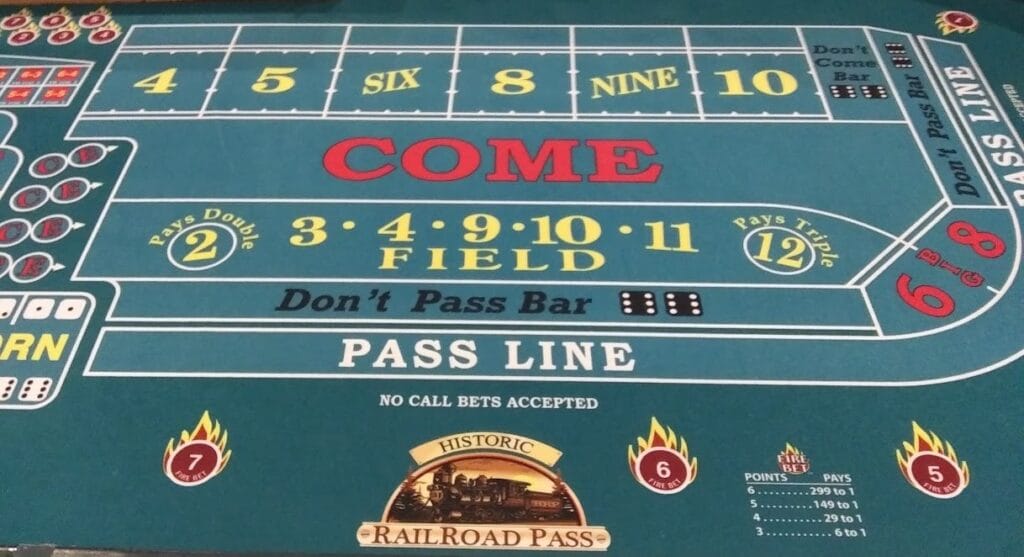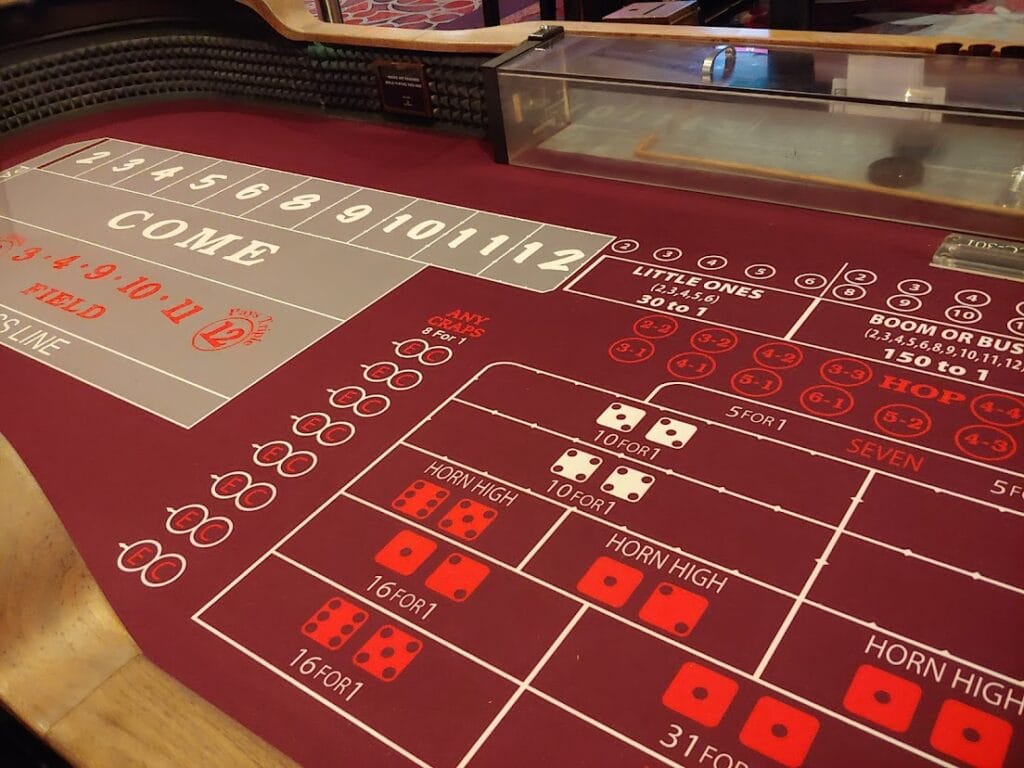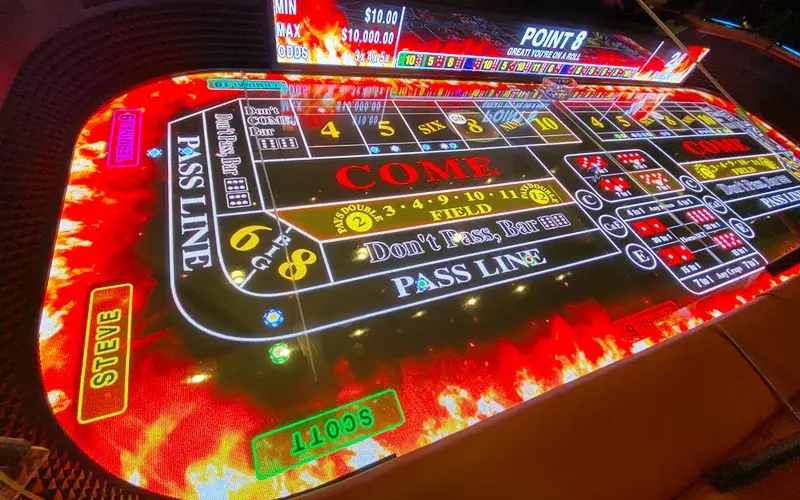Craps is a dice game that’s incredibly popular, especially in the United States. If you want to improve your odds, you need to follow the best Craps strategy for beginners. This way, you can reduce the house edge to just under 1%. Almost every online casino offers this game — including fast credit card deposit casinos not governed by GamStop, which make it easy to jump in and start playing. That’s why we’ll tell you everything about betting on Craps at non GamStop casinos and which strategy to follow.

Best Non GamStop Casinos for Testing Craps Strategy
You can test your Craps strategy at several top non GamStop casinos. These online casinos offer Craps and have also passed our security check. Before you can use a Craps strategy, you must deposit funds into your account. We recommend playing at casinos with reliable payment providers, such as Paysafecard or Volt — both of which are among the payment options available at Kingdom Casino, ensuring fast and secure transactions.
- Roi Bets
- Harry Casino
- Bet Ninja
- Great Slots
- The Phone Casino
The Best Craps Strategies
Everyone has their own way to win real money at Craps in an online casino. That’s why we’ll highlight a few Craps strategies for you. The first is the Pass Line.
Pass Line, Come Bets, and Odds
If you are learning craps, start with the Pass Line. It is the simplest path to fair payouts and one of the lowest house edges on the table. For a simple craps strategy for beginners, the Pass Line with odds is the core.
Here is how it works. The first roll of a round is the come out roll. If the shooter rolls a 7 or 11, Pass Line bets win right away. That happens 8 times in 36, which is about 22.22 percent. If the shooter rolls 2, 3, or 12, Pass Line bets lose. That happens 4 times in 36, about 11.11 percent. Any other number 4, 5, 6, 8, 9, or 10 becomes the point. After a point is set, your Pass Line bet wins if that same point repeats before a 7 appears. It loses if a 7 shows first.
The built in house edge on a flat Pass Line bet is about 1.41 percent. You can lower your overall cost by taking the free odds behind your Pass Line bet once a point is set. The odds bet pays at true odds, which means there is no built in house edge on that portion. The payouts are 2 to 1 on points 4 and 10, 3 to 2 on 5 and 9, and 6 to 5 on 6 and 8. Many casinos allow what is called 3-4-5x odds. With that structure, your overall house edge, measured against the total you have on the layout, can drop to well under 1 percent. With full 3-4-5x odds, it is roughly 0.37 percent. You are risking more total dollars to achieve that lower percentage, so set a limit that fits your bankroll.
You will often hear table advice like do not add more bets when the point is 4 or 10, but consider the real reason. Those points are harder to make than 6 or 8, so taking odds on 4 or 10 swings your results more than on 6 or 8. That is not wrong, it is just higher variance. A calm plan for a new player looks like this. Make a Pass Line bet. When a point is set, add single or double odds if your bankroll can handle it. If the point is 6 or 8, you can be a little more comfortable boosting your odds since those numbers roll more often.
Come bets are simply Pass Line bets made after a point is already set. They follow the same rules on their own mini timeline. Many players who follow a craps strategy for beginners like to add one or two Come bets, then take odds on those as well. This spreads risk across two or three numbers and keeps you in action without crowding the layout with side bets. A common example is Pass Line with odds, then one Come bet with odds targeting 6 and 8 when they establish.
If you want a practical picture, imagine you bet $10 on the Pass Line. A 9 is rolled, so 9 is the point. You add $20 in odds behind your line bet. Next roll is an 8, so you make a $10 Come bet. The roll after that is a 6, which moves your Come bet to the 6. You add $12 odds behind it to match the 6 to 5 payoff structure. Now you are set on 9 and 6 with odds, and you can let the dice work. You did not chase every roll, and you kept the house edge concentrated on simple, fair bets.

Place Bets vs Big 6 and Big 8
After you learn the Pass Line and Come bet ideas, the next choice is whether to bet directly on numbers. The table offers Big 6 and Big 8 in the corners, and it also lets you make Place bets on 4, 5, 6, 8, 9, and 10. These are not the same.
Big 6 and Big 8 win if 6 or 8 is rolled before a 7, and they pay even money. That even money payout is the key. Over time, 7 appears in 6 ways out of 36, and 6 appears in 5 ways out of 36. In a race where only 6 and 7 matter, the chance that 6 shows before 7 is 5 out of 11, about 45.45 percent. Winning an even money bet 45.45 percent of the time produces a house edge of about 9.09 percent. That is costly.
Place bets on 6 and 8 win in the same basic way, but they pay more than even money. The standard payout is 7 for 6, which is 1.1667 to 1. That higher return cuts the house edge to about 1.52 percent when you bet in correct multiples of 6 dollars. For 5 and 9, Place bets pay 7 for 5, and the edge is about 4 percent. For 4 and 10, the payout is 9 for 5, and the edge is about 6.67 percent. This is why most dealers and seasoned players suggest you skip Big 6 and Big 8 in favor of placing the 6 and 8.
If you are building a craps strategy for beginners, favor placing the 6 and 8 in small, right sized units. For example, place $12 on the 6 and $12 on the 8. Each time one hits, you are paid $14. You can press a little or rack the win. If a 7 rolls, both Place bets come down, which is the normal risk you accept when you bet against the 7. The math is still in your favor compared with Big 6 and Big 8 because you paid for a better return on the same race.
It also helps to understand how Place bets interact with your line play. If your point is 6, you do not need to also place the 6, because your Pass Line and odds are already covering it. Instead, place the 8, or add a Come bet that might travel to 8 or 5 or 9. Keeping bets from overlapping the same number is one of the cleanest ways to control variance. You are still giving yourself two or three ways to win without creating duplicates.
Why 6 and 8 are favorites for new players
There are 36 possible two dice outcomes. Six of them total 7. Five total 6. Five total 8. No other box number has that many combinations. This is why 6 and 8 appear a little more often than 5 or 9, and much more often than 4 or 10. That small edge in frequency is exactly why casinos pay a little less on 6 and 8 odds and Place bet payouts. Even so, the combination of fairer payouts and higher hit rates makes 6 and 8 friendly anchors for new players.
You can use that knowledge to shape your layout. When no point is set, your best move is to wait for the come out roll. When a point is set, ask yourself whether you are already covered on 6 or 8. If not, a single Place bet on one of them is a simple way to be involved without cluttering the felt.
Putting it all together
A steady plan for the first hour at the table might look like this. Make a modest Pass Line bet. If a point is set, take single odds that match your bankroll. If the point is not 6 or 8, consider placing either the 6 or the 8 for $12. If the point is 6 or 8, place the other one instead. Add one Come bet now and then, and take odds on it after it moves to a number. Avoid Big 6 and Big 8 since they pay even money, and consider skipping side bets that have higher edges until you are more experienced.
This plan keeps your focus on fair bets. It also teaches you how the flow of the game works. You learn to count the come out roll, point cycles, and the rhythm of moving chips behind the line for odds. Most of all, you avoid the trap of stacking many small side bets that add up to a high cost over time.
If you want a simple rule of thumb, think in layers. The flat Pass Line is your base. Odds are your booster. A Place 6 or Place 8 is your helper. A periodic Come bet can be your second lane. Review your bankroll every few shooters. If the table gets fast and you feel rushed, pull back to the Pass Line only until you feel calm again.
That is the heart of a table plan that new players can keep for years. It uses the cleanest bets, it respects variance, and it fits most bankrolls. If you later choose to add more advanced moves like pressing place bets or laying odds against a point, you will be doing it from a stable base rather than from a guess.
A calm, numbers based approach is what turns a loud game into a clear one. If you shape your choices around the Pass Line with odds, sensible Come bets, and place betting 6 and 8, you will be using the same ideas that many long time players trust. In any craps strategy for beginners, that foundation is the goal.
Don’t Pass bet
Actually, we’ve been lying. There’s a bet that has better odds than the Pass Line, and that’s a Don’t Pass bet. However, players consider this improper according to Craps etiquette. You’re betting against the game and the shooter. While everyone else is cheering for numbers other than 7, you’re hoping for the so-called S-word. If you win, don’t shout for joy — most players have just lost their bets. This kind of emotional awareness is part of Responsible gambling policies, which emphasize respectful behavior and self-control at the table.
Craps Rules When You Travel: What Changes by Region
If you learned to play in one city, the first surprise on the road is that craps is mostly the same but small house rules can change the math, the pace, and even your usual moves. Use this traveler’s guide to spot the key differences before you buy in.
The first things to check at any table
Before you place a bet, scan the layout frame and placards. Casinos usually post the rules that matter most for your wallet.
- Odds multiple: Some tables allow single odds, others allow 3-4-5x, 10x, 20x, or even 100x. Higher odds lower your overall house edge, but increase your total at risk.
- Don’t Pass “bar” number: Most U.S. tables read “Bar 12,” which means 12 is a push on the come out for Don’t Pass. A few rooms use “Bar 2,” which pushes a 2 instead and changes the edge slightly.
- Buy and Lay commission (“vig”): Some casinos charge the 5 percent commission up front, others only on wins. Rounding rules also differ, which affects the return on $20 or $25 buys on 4 and 10.
- Place bet minimum units: 6 and 8 usually need bets in $6 multiples for full pay. Policies on paying short amounts vary by room.
- Side bets allowed: Fire Bet, All Tall Small, and similar props are allowed in some jurisdictions and not in others.
- Dice handling rules: All rooms require one hand on the dice and a hit on the back wall. Some are stricter about dice setting, late betting, or talking over the layout.
- Table limits and currency: Minimums can be higher in tourist zones and during peak hours. Outside the U.S., chip denominations and tipping customs may differ.
United States
Las Vegas Strip vs Downtown
Rules are broadly standard. Many Strip casinos post 3-4-5x odds, while downtown properties often experiment with 10x, 20x, or promotional odds. Big 6 and Big 8 spaces are disappearing in some rooms in favor of Place bets. Buy vig on 4 and 10 is commonly charged on wins, but a few places take it up front.
Atlantic City and East Coast
Expect 3-4-5x odds at most tables. Buy and Lay commissions are usually on wins, with clear rounding rules. Side bets like Fire or All Tall Small may be present depending on the property. Tighter enforcement around late bets and dice hitting the wall is common on busy nights.
Reno and Lake Tahoe
You may see the “Bar 2” layout on the Don’t Pass and Don’t Come, which nudges the math against the dark side slightly compared with “Bar 12.” Always check the rail placard for the posted rule.
Mississippi and the Gulf Coast
Standard bank craps is common, and some rooms spread “Crapless Craps” where 2, 3, 11, and 12 become points on the come out instead of immediate losses for the Pass Line. Crapless tables feel friendly but carry a higher overall house edge. Buy vig policies vary, so ask whether the commission is taken up front or on wins.
Midwest and Tribal Casinos
Rules are close to Vegas norms, though maximum odds and side bet availability depend on state regulations. Electronic and “stadium” craps are popular where staffing is tight or demand is high.
Canada
Craps is offered in major destination casinos and some provincial properties. Odds multiples vary by room. Buy and Lay commissions are usually on wins, and dealers will expect proper Place bet units on 6 and 8. Smoking rules, chip denominations, and tipping customs can feel a little different from U.S. resorts, so take a moment to watch a few rolls before you buy in.
Caribbean and Mexico resorts
Tourist casinos often spread friendly, low-limit tables with simple side bet menus. Odds multiples may be lower at peak times. Some resorts post vig up front on Buys and Lays and round commission to the nearest dollar, which affects small bet sizing. Service pace and etiquette can be more relaxed. Confirm minimums and payout details with the dealer before you set odds.
Europe and the UK
Craps is less common than roulette or blackjack, but you can find it in major destination casinos. Tables may open late and close early compared with North American rooms. Odds multiples are typically modest. Verbal “call bets” are not standard practice on craps in most European casinos, so place your chips before the stick returns the dice. Minimums can be higher in city centers.
Play Craps Online
Before you can test a Craps strategy, you need to choose a casino. Where can you actually play Craps? Non GamStop casinos often offer multiple Craps tables. It’s easy to fully test the Craps strategies outlined in this article here. You play with live dealers, with whom you can communicate. The downside is that dealers try to encourage players around the table to bet, preferably ones that maximize the house’s advantage. Many players get carried away. This makes it tempting to forget the Craps strategy and make less sensible bets.
